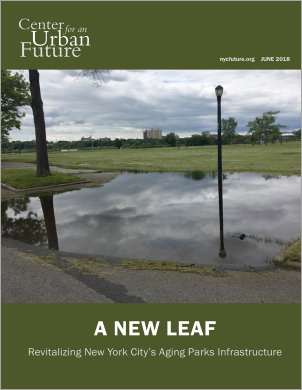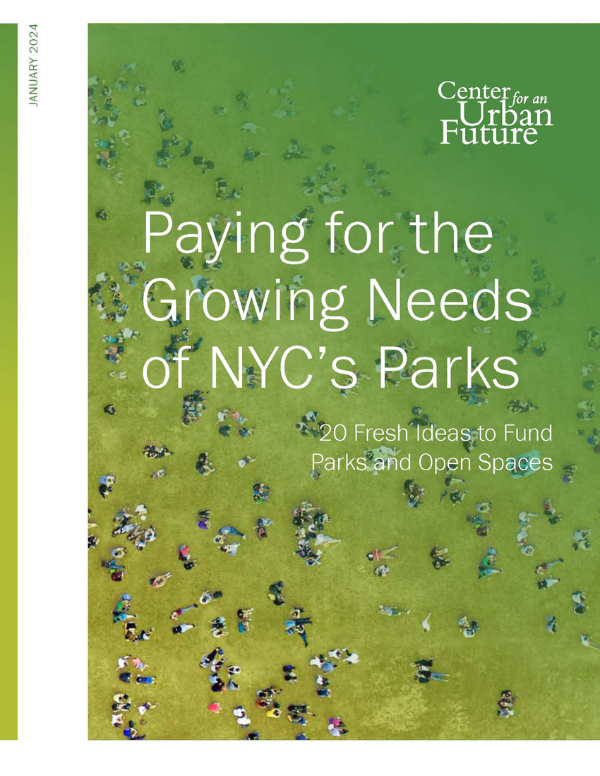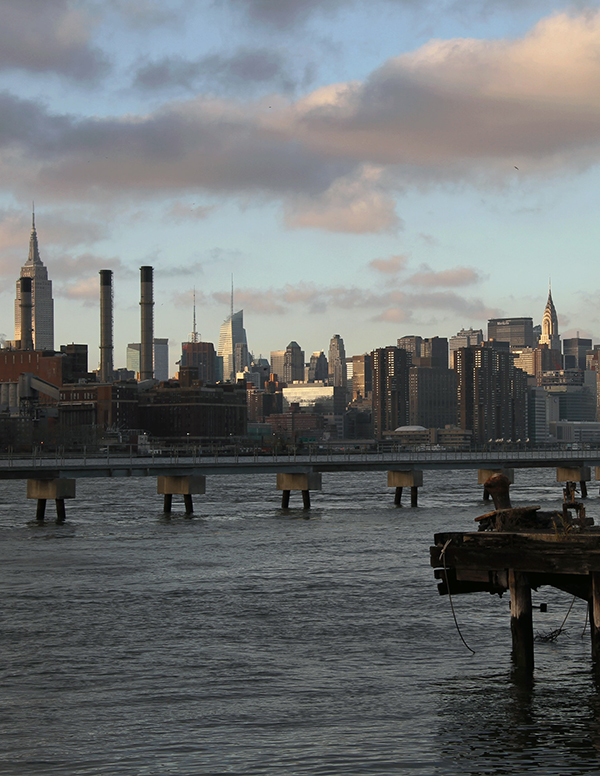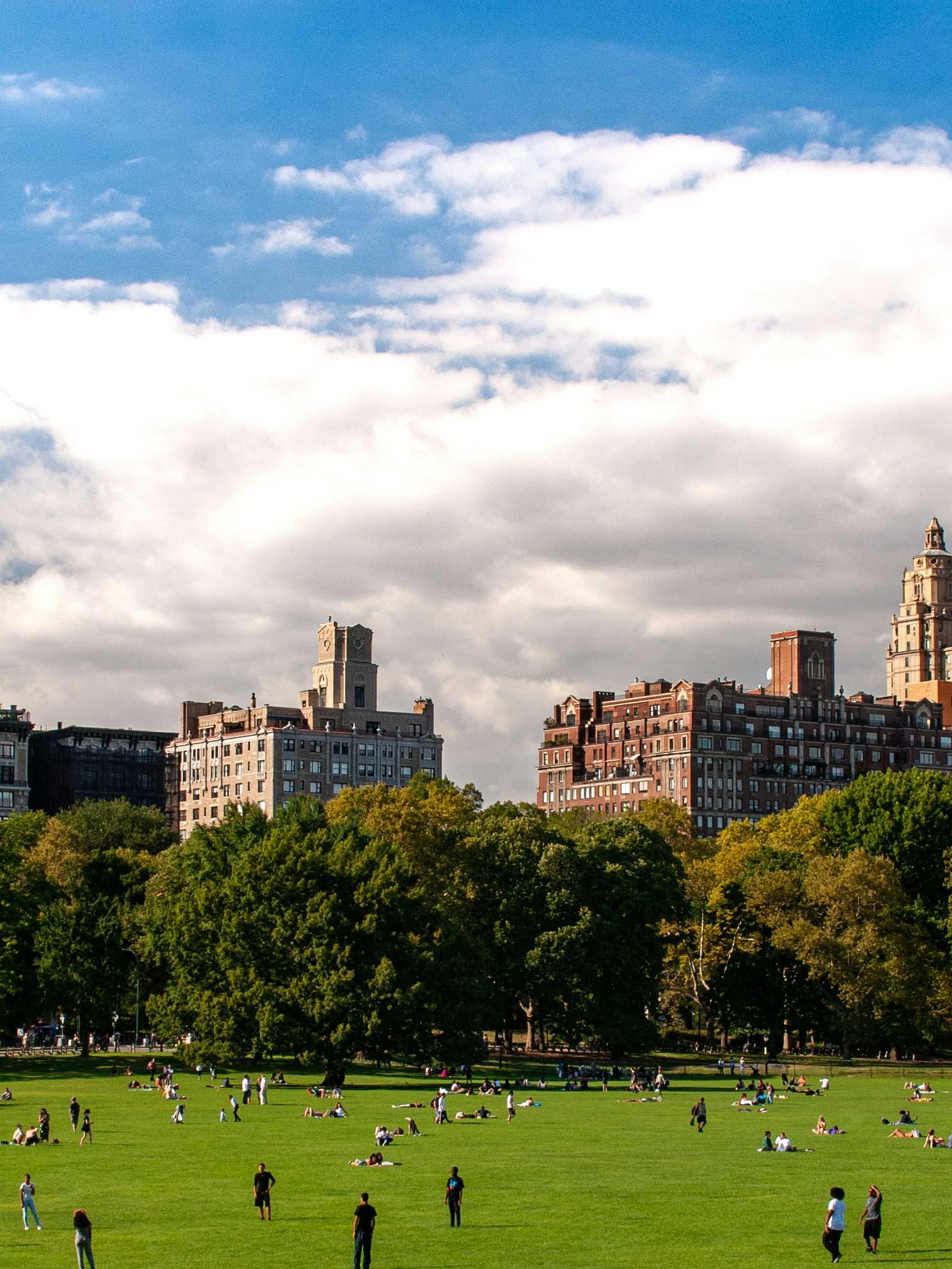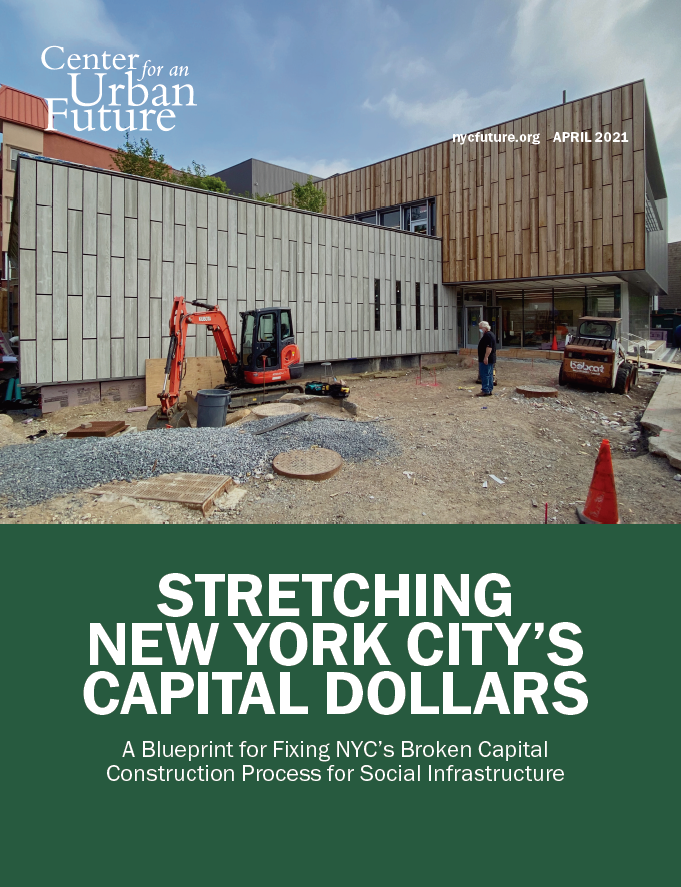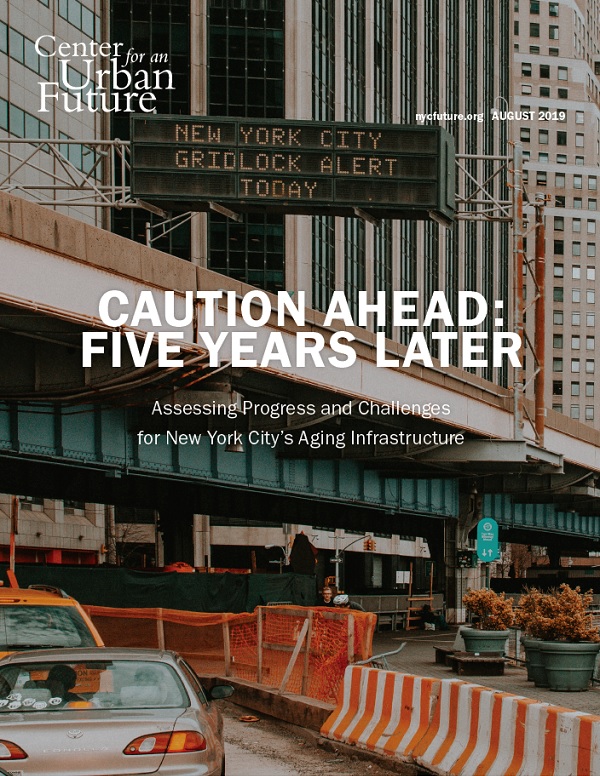- The following are recommendations from A New Leaf: Revitalizing New York City's Aging Parks Infrastructure
- Read the full report (PDF)
In a city as old as New York, maintaining and upgrading essential infrastructure is a near-constant struggle. But while many New Yorkers are familiar with the city’s aging streets, bridges, subways, libraries, and schools, there is little awareness of the age and infrastructure challenges facing the city’s public parks. As parks usage surges and state of good repair needs continue to grow, New York City will need to make substantial and sustained new investments in maintenance and staff, while allocating new unrestricted capital funding for renovations and upgrades.
Improving How NYC Pays for Parks
Make investment in New York City’s aging parks infrastructure a priority for the de Blasio administration’s second term. Parks are vital to the life, health, and economic future of New York City. However, insufficient maintenance over decades, coupled with the vulnerabilities of an aging system, has resulted in major unaddressed infrastructure problems. Despite some major new investments in parks, the Parks Department lacks the capacity to systematically identify infrastructure needs and address them in a timely and cost-effective manner. In order to sustain the city’s public parks for the next generation and beyond, city leaders will have to develop and implement an infrastructure restoration plan and make parks infrastructure a priority citywide.
Fund a larger expense budget for the Parks Department. Despite important increases to its expense budget in recent years, the Parks Department continues to suffer from limited capability to maintain and repair vital infrastructure, such as retaining wall restoration, horticultural upkeep, and drainage system maintenance. Although the current administration has increased the Parks Department’s maintenance and operations budget from $223 million in FY 2014 to $306 million in FY 2018, further increases should be planned over the next five years to enable the agency to begin closing the gap between its mounting infrastructure maintenance needs and its current capabilities. In particular, this funding should be used to strategically increase the number of full-time maintenance and operations staff with specific technical skills, such as gardeners and foresters, masons, plumbers, electricians, mechanics, and other skilled workers. This will allow the Parks Department to better maintain existing infrastructure and perform essential preventative maintenance, rather than relying on discretionary funding for capital work once systems break down, saving the city time and money and improving the condition of parks in the process.
Establish a sustained stream of capital funding for routine state of good repair investments. In order to prioritize infrastructure projects based on need, the Parks Department needs capital funding that is not contingent on the preferences of individual elected officials. A better alternative would be a sustained stream of capital funding that allows for increased state of good repair investment and long-term infrastructure planning. To the de Blasio administration’s credit, the Parks Department’s capital budget has been increased significantly in recent years, with a much-needed focus on renovating aging parks, but more needs to be done to ensure that essential upgrades can be scheduled and executed at the optimal time. The city should establish a state of good repair capital budget of $100 million per year, to be allocated at the discretion of the commissioner, in order to meet these mounting needs. These funds can be used for projects that are unlikely to get funded otherwise and provide last-in dollars—the final sum required to fully fund a project—on projects that are primarily funded with council allocations, avoiding unnecessary delays. The current discretionary model— both for City Council members and borough presidents— should be encouraged for supplemental projects, not essential repairs. At the same time, a lengthy approval process has undermined the intent behind the system’s “requirements contracts,” which were initially created to efficiently dispatch work crews to address infrastructure problems, without taking on more responsibilities in-house. The use of these contracts should be expanded, and the approval process simplified, so that state of good repair work can be undertaken more efficiently.
Identify innovative revenue streams and new ways of capturing value from parks infrastructure. Unlike other cities’ parks systems, state law largely limits potential sources of New York City’s parks funding. City residents are unable to vote on a referendum for parks funding—which has been immensely successful in other cities—nor is the Parks Department allowed to levy a tax specifically for parks, as is the case in Chicago and Minneapolis. In order to make progress on addressing the city’s parks infrastructure needs, New York will have to develop new, innovative revenue streams for its parks.
In several other states, a small surcharge on sporting and concert event tickets is used to generate maintenance funding for parks and recreation. New York State should adopt a similar surcharge to fund parks maintenance, as well as a surcharge on greens fees at golf courses within the five boroughs. The city should also consider adding a small surcharge onto dockage fees at its publicly owned marinas, which could be allocated directly to the maintenance of waterfront park facilities. It’s also worth exploring a program like Pennies for Progress in South Carolina, where a one-cent surcharge on sales taxes has raised millions for capital projects. In addition, the City Council should pursue more systematic inclusion of parks funding as part of rezoning agreements for new developments, which are often required to mitigate issues around parking, transit, and public safety, but rarely required to fund open space provision, improvements, or ongoing maintenance.
Increase the revenue generated from parks concessions. In FY 2018, the Parks Department expects to collect $70.5 million from the concessions, leases, and rentals on parkland. However, this revenue has remained largely flat over the years and is down 22 percent from the FY 2007 total of $75.8 million, after adjusting for inflation. New York City has enormous potential to increase parks’ earned revenues significantly, while focusing on opportunities that enhance the experience for parkgoers and generate opportunities for local businesses.
One factor disincentivizing sustainable revenue growth is the fact that these funds ultimately return to the city’s General Fund, and are not applied to the parks system’s needs. Instead, fees from new concessions should be at least partially dedicated to fund park operations, as in the case with Madison Square Park, where concessions revenue helps pay for a well-equipped operations team as part of a contract with the Madison Square Park Conservancy.
New concessions can add to the surrounding communities’ park experience, while supporting local entrepreneurs. These approaches might include inviting small, local businesses—like food trucks, flea markets, or stands—into parks to vend goods and services, or creating occasional or seasonal festivals. Successful examples that could be strategically expanded include the popular local food vendors at the renovated Jacob Riis Park in the Rockaways; the homegrown food stands in Flushing Meadows Corona Park; or the upcoming hyper-local market planned for St. Mary’s Park in the South Bronx. In addition, major park developments—such as the East Side Coastal Resiliency Project along the Manhattan shoreline—should integrate concessions into the fabric of the parks during the design phase.
The Parks Department, in concert with the mayor’s office, should take steps to increase concession revenues by 20 percent over the next four years—an achievable goal, given that concessions revenues have been higher than that in the recent past. The Parks Department can set up a task force—drawing on expertise within NYCEDC, the Department of Small Business Services, and nonprofit small business intermediaries—to generate ideas on how to accomplish this, while maintaining a focus on improving the experience for parkgoers and complying with the department’s appropriate use requirements for concessions.
Create a citywide parks conservancy to help fundraise for neighborhood park projects. Many parks volunteer groups and community organizations told our researchers that they face institutional barriers to receiving grants to conduct parks projects in their neighborhoods. The work performed by organizations like Partnership for Parks and City Parks Foundation to nurture “friends of” groups and recruit volunteers has been beneficial for boosting maintenance in the absence of sufficient funding. However, the city can do more to help community groups interested in making improvements to local parks with fundraising activities. This could include grant writing and development coaching, free accounting and bookkeeping services, and helping nonprofit community organizations act as fiscal sponsors for smaller groups.
In Dallas, for example, a citywide parks conservancy acts as an intermediary to help raise funds for park projects in historically underserved areas and accepts donations for groups that are not 501(c)3 nonprofits. Although New York’s City Parks Foundation offers fiscal sponsorship services, the city can do more to unite the existing patchwork of conservancies and other nonprofits and connect local organizations to technical assistance and funding opportunities. The Parks Department should explore a model similar to the Borough Arts Councils, which can help civic groups acquire low-cost fiscal sponsorship and disburse funding to individuals and informal associations dedicated to a specific park.
Improving How NYC Maintains Parks
Increase maintenance and operations staffing levels to support parks, playgrounds, gardens, horticulture, and other parks assets. New York City’s parks lack sufficient levels of maintenance funding and staffing to ensure that the system can be sustained at a time of ever-increasing demand. Deferred parks maintenance needs have increased 143 percent over the past decade, from $14 million to nearly $34 million. Meanwhile, the Parks Department’s gardeners, foresters, masons, electricians, plumbers, and engineers are stretched thin—especially in small and medium-sized parks in the boroughs outside Manhattan. The result is that maintenance needs continue to climb with insufficient levels of skilled workers to handle the backlog. Although conservancies and outside park groups help to narrow the funding gaps for certain parks, the current level of maintenance and operations staffing afforded to parks is too low to ensure adequate capacity across the system. Instead, infrastructure is allowed to degrade until it collapses, necessitating expensive and time-consuming capital construction projects. The city should commit to increasing the Parks Department’s full-time headcount, which is currently 35 percent below the level of the early 1970s, and allow for the strategic hiring of additional skilled workers in every borough.
Revamp the Parks Opportunity Program as an initiative to develop career pathways in green infrastructure. While nominally beneficial for cost-saving purposes, the Parks Department’s heavy reliance on temporary workers via the Parks Opportunity Program presents problems for parks infrastructure. Turnover and transience built into the current model means that supervisors are stretched thin, skills-building achievements are limited, and few workers are able to gain meaningful competencies for future employment. A high turnover rate and a lack of full-time opportunities inhibits workers from learning more advanced skills, and deprives the Parks Department of a potential pipeline of more specialized green infrastructure professionals.
The city and the Parks Department should work with existing partners and other successful skills-building organizations to re-launch POP as a job training program that offers concrete paths to careers in growing fields of green infrastructure, including public horticulture, forestry, invasive species mitigation, and stormwater management. In addition, an apprentice program should be developed in partnership with a union or major private sector employer to train workers in technical skills such as outdoor plumbing, electrical work, masonry, and even blacksmithing.
A robust full-time staff of specialized workers who can effectively respond to infrastructure demands would save the city millions of dollars in the long-term, as more is spent on maintenance and less on larger capital restorations. Ultimately, the city should rethink how it trains park workers, ensuring that job seekers have the skills necessary to support the modern parks system that New York City needs.
Mandate detailed maintenance plans for capital projects. Through regular assessment and standardization, various categories of capital project maintenance can be streamlined to ensure timely inspection and routine care. With the Community Parks Initiative projects, the Parks Department has begun implementing this model to better manage its limited resources, but too many capital projects still end up funded without commensurate planning for long-term maintenance and repair. At the same time, certain infrastructure categories have not yet received maintenance plans, such as drainage and retaining walls. The city should mandate and expedite this process and require detailed maintenance plans for all parks assets, which will ensure that routine repairs are accomplished at effective intervals, while minimizing long-term capital needs.
Set a maintenance schedule for park streets, sidewalks, and stairs. While some streets in parks are overseen by DOT—namely, those that carry motor vehicle traffic— most sidewalks, pathways, and stairs are not. Unlike DOT, the Parks Department does not have mandated inspection schedules for park roads and other pathways based on average daily usage, nor a way to perform upkeep aside from a costly capital restoration. The Parks Department needs a fully funded maintenance schedule, developed in partnership with DOT, to assess the condition of pedestrian pathways and DPR-administered park roads, to help the Parks Department ensure that its paths are safe and accessible to all.
Improve parks infrastructure through testing of new designs and materials that meet the needs of modern users, and reduce long-term energy and maintenance costs. Parks worldwide are finding innovative ways to build better and smarter structures, enhancing the experience for visitors and finding long-term cost savings. New York’s Parks Department should test new designs such as composting comfort stations in areas without sewer service; solar-powered charging stations, concessions, and amenities; and modular structures made from energy-capturing fabrics and recycled materials. The Parks Department has taken steps to streamline the design of comfort stations by reusing prior designs—an approach that is saving time and cutting design costs—and this approach should be expanded to other infrastructure types. Meanwhile, the city’s parks can do more to pilot new systems and structures that are optimized for long-term maintenance efficiency and to reduce waste, while capturing better data on park usage patterns. Testing these technologies now can yield real benefits in the future: for example, the upfront cost of composting comfort stations can be offset by a longer lifespan, and reductions in energy use and waste.
Improving How NYC Plans for Parks
Create a City Parks Board charged with long-term planning across administrations. As one experienced park designer notes, work with the Parks Department can be “unpredictable,” as mayoral initiatives and priorities change with each passing administration. Since infrastructure priorities are so closely tied to the wishes of elected officials, this model inhibits the sort of long-term planning that the system requires to address its infrastructure needs.
To help steer the city’s parks system on a long-term course, New York should create a City Parks Board, which would be charged with outlining the five-year, ten-year, and long-term needs of the city’s parks system, along with regular reassessments, and developing specific strategies to fund and maintain them. Such a system can help the city look beyond its short-term preferences and instead develop a sustainable trajectory for the next century of New York City’s public parks.
Fully fund a regular system-wide needs assessment, and other data-gathering initiatives. Adequately addressing the city’s parks needs starts with knowing where the problems are. To do so, the city needs to fully fund and expedite the Parks Department’s first-ever system-wide needs assessment. At the current rate, this assessment could take 20 years to complete, at which point major infrastructure categories will have already exceeded their lifespans. Completing this assessment quickly and efficiently should be a top priority. Only then can the Parks Department comprehensively evaluate the parks system, prioritize resources based on metrics, and develop an asset management system that brings New York’s parks up to speed with those of leading cities.
To better understand and mitigate widespread drainage problems, the Parks Department should allocate maintenance funding to comprehensively assess flooding issues across the system and develop sustainable, water-sensitive green infrastructure solutions as a better alternative to replacing aging drainage structures.
Expanded data collection is needed for effective horticultural and natural areas management. The city should fund a comprehensive map of the gardens and plantings in all five boroughs, to ensure that maintenance schedules are responsive to the needs of different environments and staffing levels are sufficient to ensure proper care. In addition, PIP surveys should expand to include vital natural areas beyond the reach of existing trails, in order to supplement the work of the Natural Areas Conservancy and ensure that natural areas are regularly inspected in the future.
Lastly, the Parks Department should strengthen its ability to pinpoint stressed infrastructure by factoring in usage data. DPR’s Parks Usership Program is beginning to collect this crucial data, but this effort should be accelerated to cover most city parks by 2020.
Expand the Community Parks Initiative, Parks Without Borders, and Anchor Parks. The de Blasio administration’s signature parks initiatives have allocated desperately needed resources to historically underserved parks across the city. By focusing on population density, a historic lack of capital funding, and community involvement, these programs are increasing equity across the system and making substantial improvements in crumbling infrastructure. But given that fewer than one-third of parks found eligible for the Community Parks Initiative have received funding through that program, along with just 8 of 691 parks that applied for Parks Without Borders, these initiatives should be expanded to meet the overwhelming demand.
Supplement AIMS with a database of parks assets that includes key categories left out of the current system. The city’s asset information management system has serious limitations when it comes to adequately capturing vital park needs. The current system is designed to catalog only assets with a replacement cost greater than $10 million, and excludes “landscaping or outdoor elements” and “aesthetic considerations,” which are key elements of any park. To enable better long-term planning and offer a clearer portrait of the state of parks infrastructure in New York City, the Parks Department should supplement AIMS with its own database of parks assets, which could include all assets with a replacement cost above $1 million, as well as the major landscaping elements that AIMS leaves out.
Encourage more skill sharing and coordination among agencies. When it comes to parks infrastructure projects that span the roles of different agencies, a lack of clear responsibility can stymie effective coordination. All too often, critical maintenance tasks—like unclogging catch basins or inspecting bridges—fall by the wayside, as each agency assumes the other is in charge. In addition to quarterly meetings on capital projects—a recent and welcome development—DPR, DEP, and DOT should develop a framework for handling routine maintenance and inspection duties in the most cost-effective way possible. For example, DEP has backed away from sewer line work in parks, including catch basin clearance, leaving the job up to the Parks Department, yet DEP has expertise and resources that DPR lacks.
In addition, projects such as bioswales for street trees and greenways in parks show the promise of integrating DOT’s planning capabilities with DPR’s expertise in maintaining green infrastructure, but these multifunctional infrastructure projects should be developed on a larger scale. Ultimately, better coordination among agencies can eliminate redundancies, improve the way maintenance is scheduled and delivered, and develop more effective ideas for renovations and upgrades.
Complete a comprehensive parks bridge survey. Under the current system, a park bridge must either be specifically funded for inspection or part of DOT’s inspection program before regular inspections can occur. As a result, there are an unknown number of park bridges that have gone uninspected for years. In conjunction with DOT engineers and DPR inspectors, a comprehensive bridge survey should be funded to locate and assess the condition of every park bridge, and these bridges should be listed for regular inspection by DOT in the future.
Invest in an interagency Green Lab. On issues of vital importance to parks—such as stormwater management, pathway maintenance, sanitation, and resiliency planning— the roles of various city agencies are inextricably linked. New York City should take a cue from the Philadelphia model, in which green infrastructure planning is coordinated across multiple agencies, and launch an interagency Green Lab to design, plan, and implement new green infrastructure projects.
Leveraging expertise and input from DPR, DEP, DOT, and even the Department of Sanitation, among other agencies, the Green Lab could pilot programs in parks, natural areas, and other open spaces, including resiliency planning for coastal areas, renewable power generation for park facilities, and smarter approaches to waste management—like the new trash management system in Crotona Park, which increased cleanliness there by 65 percent. By tapping resources from different agencies and plugging in to existing workforce development programs, the Green Lab could serve as a key training ground for green infrastructure careers. Ultimately, successful pilot programs could be absorbed into larger maintenance budgets across agencies, with innovations spread citywide.
Improving How NYC Builds Parks
Improve the capital construction process for parks. The issue has increasingly become a talking point in City Hall, but the problem remains clear: the city’s capital construction process is broken. DPR projects, in general, stand out as among the most deeply affected, as park projects are often tied up for years; a number of Bloomberg-era projects are still being completed as of this report’s publication. The agency desperately needs a capital process that can complete projects efficiently and cost-effectively, while incorporating community input when necessary. To do so, the Parks Department needs to continue making significant improvements to parts of the process that are under its control. At the same time, the city should undertake a deeper review of its capital construction issues—a process that the City Council had hoped to begin in 2017, but appears to be stuck.
DPR has implemented some reforms to the design and construction phases, with promising results. In addition, new “red zone” meetings for delayed capital projects are helping to clear the backlog, either by tackling the problem or eliminating the project entirely. However, major issues remain in both the design and procurement phases, where projects often find themselves stuck in a lengthy back-and-forth between various stakeholders, including DPR, elected officials, community organizations, and oversight agencies such as OMB.
One solution is to streamline the way repairs and maintenance are handled in order to avoid capital construction delays. A larger expense budget would give the Parks Department more flexibility to manage essential repair and maintenance projects outside the capital process. Likewise, streamlined requirements contracts can place skilled contractors on call, allowing state of good repair work to be completed much more efficiently. In addition, major capital projects should be managed using the integrated project delivery model, which ensures that all stakeholders and decision-makers are part of the same team and working together to meet a clear set of deadlines and objectives. To do so, the Parks Department should expand the use of in-house cost estimators to establish clear guidelines based on industry standards and onsite construction managers who are deputized to resolve issues as they arise.
Finally, more accountability needs to be built into the system. The Parks Department’s Capital Projects Tracker is a good start, but it lacks crucial detail. The department should be required to expand the tracker to include the dates projects were fully funded, projected and actual cost overruns, individual sources of funding, and the length of time it took to complete each project from funding to closeout, as well as reasons for specific delays.
Expedite and implement the work of the City Council’s Capital Projects Management Reform Task Force. The City Council’s Capital Projects Management Reform Task Force was expected to propose long-awaited rule changes by the end of 2017, but the task force’s current status is unclear and no public statements have been made regarding the timeline for further action. The Council should make this project a top priority for 2018, with the goal of proposing and implementing rule changes by the end of the year.
Prequalify more contractors for higher-value parks projects. As of this report’s publication, the Parks Department has prequalified contractors for “general work” projects, which are capped at $3 million. Unfortunately, given the high costs of most parks capital projects, this cap leaves out a significant portion of parks projects, which would also benefit greatly from more efficient contracting. The agency should expand prequalification to include higher-value projects. In addition, the Parks Department should work to prequalify specialized contractors for more types of projects—such as geotechnical engineers who perform pre-site inspections, drainage system specialists, and masonry contractors—which can speed up procurement from months to weeks.

